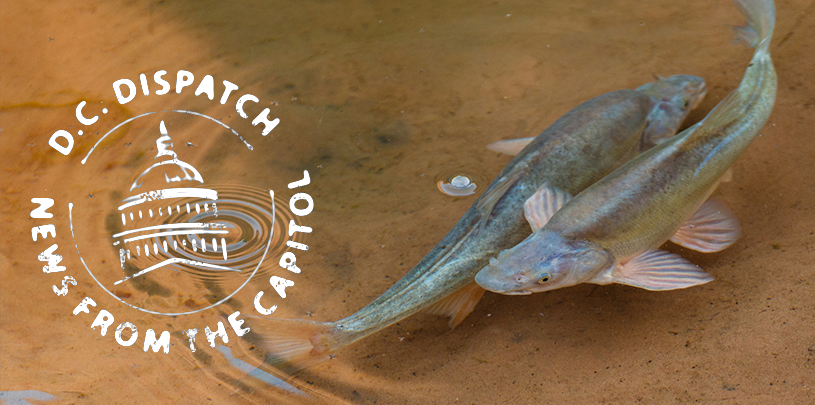
 by Travis Bruner, Arizona Forests Manager
by Travis Bruner, Arizona Forests Manager
President Trump’s Fiscal Year 2018 budget request is out, and it takes aim at water, air, wildlife, and human health by significantly cutting budgets of the agencies responsible for managing our country’s natural resources. It is a disturbing move, if not entirely surprising. Indeed, an architect of Trump’s Environmental Protection Agency (EPA), Myron Ebell, stated that the environmental movement is “the greatest threat to freedom and prosperity in the modern world.” One way to destroy that movement is to begin the systematic removal of funding for government programs it built.
This twisted view of the world no longer exists as mere rhetoric, but dominates the proposed budget that would cut the EPA by 31 percent, the Department of Interior (DOI) by 12 percent, and the Department of Energy (DOE) by 18 percent. We entrust these federal government agencies to keep water safe for drinking and swimming, oversee our national parks, and develop alternative energy technology in pursuit of greater energy independence. While stomping out much of that work with the proposed budget cuts, the Trump administration would pump $54 billion additional dollars into defense spending, which already constitutes the majority of federal discretionary spending.
The Trump administration claims to focus on defending Americans from threats, but that focus apparently doesn’t extend to assuring that our water and lands receive important protections from contamination. Rather, the president’s proposed budget cuts will slash important government agency work, sending the message that dirty air and foul drinking water are not threats to our safety.
The important work of the EPA, DOI, and DOE is already underfunded in many areas. For instance, the U.S. Fish and Wildlife Service of the DOI is short 75 percent of the funding it needs to recover endangered species. Sure, opportunities to improve efficiency and effectiveness also exist. But those areas should be carefully identified before slashing already slim budgets that we count on to protect our natural wild areas and ensure clean drinking water.
Slashing the DOI’s budget by 12 percent is equivalent to eliminating all funding for our 12 largest national parks, including Grand Canyon, Yellowstone, Yosemite, and Great Smoky Mountains national parks, while impairing natural disaster warning systems, National Wildlife Refuge visitor centers, and fish hatcheries.
If we dig a little deeper into the EPA cuts, we find that the Office of Enforcement would be cut by 23 percent, many of those cuts taking the form of staff positions. As many of us know, environmental protections offer cold comfort unless paired with effective enforcement mechanisms. Cutting the Office of Research and Development’s funding in half, as the budget proposes, would strip away our ability to study the health effects of new chemicals — a rising issue. Trump’s budget would also end the very successful Energy Star program, 25 years running, that labels energy-efficient appliances.
Trump’s cuts to the DOE represent the tip of the spear of his efforts to remove climate change from the national policy conversation. Throwing out grants to states for energy efficiency programs, the weatherization assistance program, and the alternative energy research program would thrust our country’s already lagging position on alternative energy development even farther behind other forward-looking nations in Europe and elsewhere.
The following areas of the Colorado Plateau would be vulnerable to reduced protection and management by the cuts to the DOI:
Reductions to programs that address climate change and improve energy efficiency would have disproportionate impacts on northern Arizona and southern Utah, where global warming tends to alter delicately balanced precipitation patterns that can, in the long term, harm our water supplies and wildlife habitat.
In addition to all the work the EPA performs at a national, regional and state level, the agency provides essential resources to state governments. Almost half of the EPA’s dollars end up with state agencies, and since 1988, Arizona has received $615 million from the EPA just for projects that protect water quality and improve water and energy efficiency.
Trump has put forward his proposed budget, but it’s up to the House and Senate to shape and ultimately return some version of the budget to the president for his signature. During the congressional review that has already begun, we can make our voices heard.
The Trust and several allies sent senators and representatives a letter asking them to oppose cuts to conservation, natural resources, and environmental programs in the Fiscal Year 2018 budget request.
Your voice matters too — act now by calling or writing your senators and representatives. Ask them to oppose cuts to federal government agencies and programs that protect our human health, wildlife, and natural areas.
Here are a few suggested talking points:
Sign up for alerts and take action to defend our public lands ›
Proposal to build massive communications tower on state lands inside Bears Ears National Monument withdrawn
Read MoreThe Navajo Nation and communities along the haul route oppose uranium transport from Grand Canyon region mine.
Read MoreDeveloper's attempt to dam a canyon near the confluence of the Colorado and Little Colorado rivers halted.
Read More